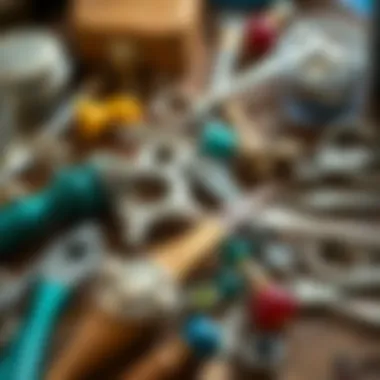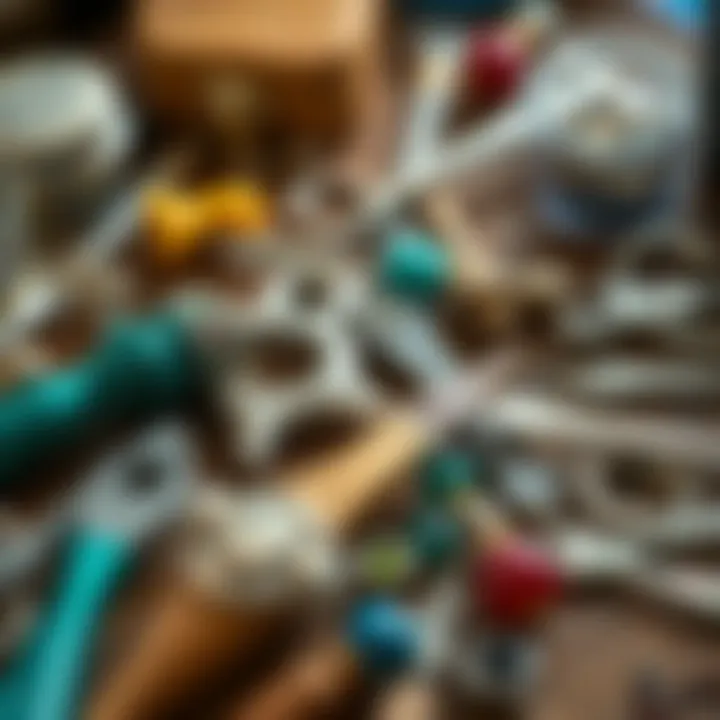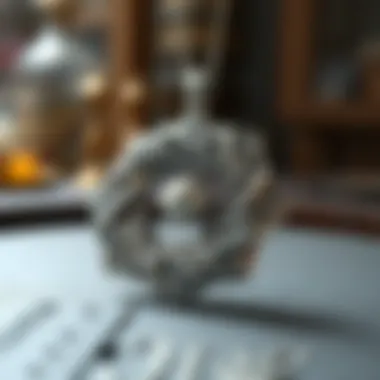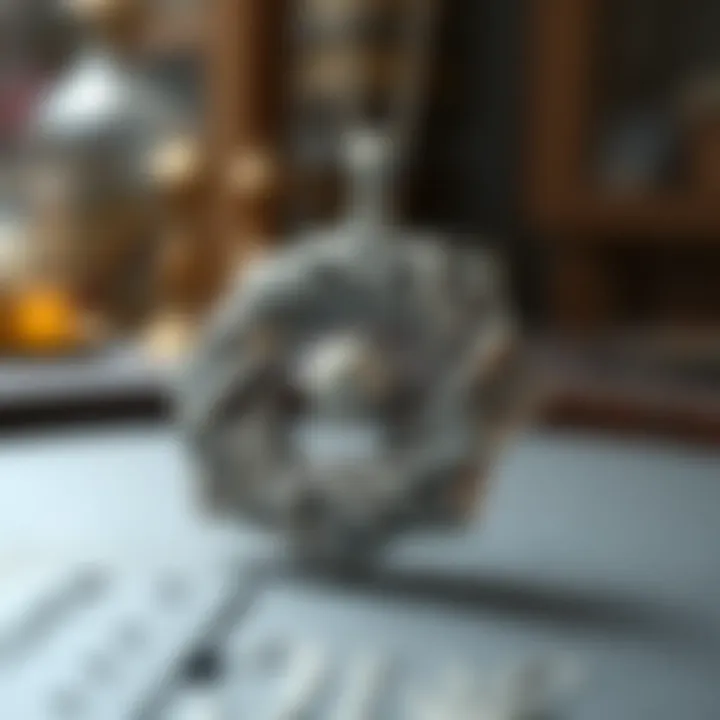A Comprehensive Guide to Silver Clay Jewellery Kits


Intro
In the ever-evolving world of jewellery making, silver clay stands out as a fascinating medium that marries creativity and craftsmanship. Within this realm, silver clay jewellery kits offer an accessible way for enthusiasts of all skill levels to delve into the art of creating stunning pieces. These kits typically come equipped with everything needed to get started—from the silver clay itself to essential tools, instructional guides, and sometimes even embellishments to personalize your creations. Leap into the deep end of artistic expression with silver clay, which allows for truly unique pieces that reflect the maker's personal style and vision.
This guide endeavors to unpack the complexity of silver clay jewellery kits, focusing on their components, the techniques employed in working with the material, and the broader implications for both novices and seasoned artisans. In addition, we'll touch on vital safety practices and considerations that are integral to handling silver clay and using the included tools effectively. With this information, anyone can feel empowered to explore the possibilities that silver clay offers in creating one-of-a-kind jewellery.
Preamble to Silver Clay
Silver clay is growing more and more popular in the world of jewellery making. It offers a unique blend of simplicity and versatility, making it an interesting option for both amateurs and seasoned professionals. Understanding silver clay is essential since it lays the groundwork for the creative potentials within jewellery design. The beauty of silver clay lies not just in its physical properties, but also in the journey it invites artists to take in their craftsmanship.
Definition and Composition
To start, silver clay is a crafting material comprised primarily of fine silver particles, organic binders, and water. When shaped and then heated, the organic elements burn away, leaving behind pure silver. This composition means creators can form intricate designs and structures that would typically be challenging with solid silver. Whether it’s a delicate pendant or a chunky ring, the possibilities are endless.
The process of creating with silver clay starts with soft clay that can be rolled, shaped, and cut just like conventional clay. Once you've fashioned your piece, it goes through a transformation during the firing process. This unique feature makes it an alluring medium for artisans who want to explore their imaginative side while utilizing a material known for its noble qualities.
Historical Context
The history of silver clay is relatively short yet impactful. Emerging in Japan during the 1990s, it opened new doors for jewellery artists. Originally created to simplify the process of working with silver, it gained traction for allowing detailed designs that could be made quickly. Over the years, silver clay has evolved into a preferred choice among modern jewellery makers, appreciated for its ease of use and accessibility.
Artisans across the globe have taken to silver clay to create unique pieces that reflect their personal style and cultural heritage. From necklaces that tell a story to rings that signify important milestones, silver clay kits offer the tools necessary for artistic expression. In essence, it allows anyone to weave history and craftsmanship into wearable art.
Properties of Silver Clay
Understanding the properties of silver clay is crucial for any aspiring jeweller. Its most striking feature is its workability – it behaves like traditional clay, which means it can be easily moulded and manipulated. Once dried, the pieces remain fragile until fired but, after the firing process, they transform into resilient metallic art.
Another important property is its shrinkage; when heated, silver clay can shrink by about 10-20%. This factor is essential to take into account when designing pieces to ensure a precise fit. Additionally, silver clay can hold textures well, allowing for an array of styles from smooth finishes to elaborate patterns that mimic nature.
Finally, it's worth mentioning the versatility of silver clay in terms of combining with gemstones or other materials. This compositional flexibility opens up a wide canvas for creativity, as many artisans choose to embed various gems into their designs, thus enhancing visual appeal.
"Silver clay is not just a material; it’s a narrative waiting to be created. Each piece tells a story of the maker's journey, crafted with care and passion."
Components of a Silver Clay Jewellery Kit
The composition of a silver clay jewellery kit is pivotal. This section breaks down each part to reveal its significance in the overall crafting experience. Silver clay, being a versatile medium, requires specific tools and materials to enable crafters—from fledgling aficionados to seasoned artisans—to explore their creativity fully. When considering which kit to invest in, one must contemplate the types of silver clay, the essential tools needed, and the workspace requirements that will set the stage for successful creative endeavors.
Types of Silver Clay
Silver clay comes in a few distinct types, each serving different purposes and crafting styles. The primary types include:
- Sculptural Silver Clay: This type is particularly malleable, making it ideal for three-dimensional shapes and intricate designs. It's great for those who enjoy detailed work, like figurines or decorative pieces.
- Paper type Silver Clay: Known for its lighter composition, this form is perfect for thinner applications and can be used for delicate, filigree designs. It’s an inventive way to incorporate lightweight features that add a unique character to pieces.
- Spoon silver clay: Designed for rapid building, spoon silver is primarily used to create flat objects. This is excellent for beginners who might be exploring the world of silver clay without going all out.
The choice of silver clay impacts both the final product and the approach you take as a designer.
Basic Tools Required
To craft creations from silver clay, a few basic tools are indispensable. These include:
- Cutters: Useful for defining shapes and ensuring consistency in size across creations. A small set will give variety to your options.
- Texture Mats and Stamps: These allow for personal craftsmanship by adding unique patterns or marks to a piece. Textures can bring all the difference for jewelry that tells a story.
- A Rolling Pin: Essential for flattening the silver clay to your desired thickness. The right thickness is key to the integrity of your structure.
- A Clay Knife: This tool comes in handy for cutting and precision work. The cleaner the cut, the smoother the finish.
- Sponges and Brushes: For smoothing out surfaces and creating fine details. Spending time on these touches can elevate basic work into remarkable pieces.
Having these tools at your disposal makes the process of creating with silver clay more intuitive and enjoyable.
Workspace Essentials
Your workspace can make or break your silver clay crafting. Consider the following essentials:
- Adequate Lighting: Good lighting is crucial not just for seeing details but for maintaining a welcoming atmosphere as you craft. Natural light is often best, but a well-placed lamp can also do wonders.
- Work Surface: A dedicated table or desk where you can spread out tools and materials, free of distractions, will significantly enhance your focus and creativity.
- Safety Gear: Keep in mind the potential hazards when working with silver clay and tools. Safety glasses can protect your eyes from fine particles, while a mask might be useful if you're working with dust or fiery materials during the firing process.
- Storage for Tools and Materials: Organizing your tools and supplies efficiently means spending less time searching and more time creating. Small bins or drawers can help keep everything in its place.
By gathering the right components, you create an environment where your artistry can flourish. Focusing on these essential elements sets the groundwork for a rewarding experience in the world of silver clay jewelry, enabling endless opportunities for personal expression.
Techniques in Silver Clay Crafting
Mastering techniques in silver clay crafting is pivotal for anyone looking to create intricate, personalized jewellery. The beauty of silver clay lies not just in its composition but also in how you manipulate it. This section will dive into the foundational techniques, emphasizing how they can elevate your designs from basic to breathtaking. Understanding these methods allows creators to express their individuality and hone their craft into a fine art.
Molding and Shaping
Molding and shaping are critical stages in creating silver clay jewellery. This is where the raw material transforms from a simple lump of clay to a well-defined piece with character. It’s all about what you envision and how you bring that to life through your hands.
When you begin molding, consider the tools at your disposal. Hand tools, like shaping and carving tools, will play a significant role in achieving the detail you want. For larger pieces, a template or mold can be handy. It’s important to remember that silver clay remains pliable for a limited time. Once you’ve finished your initial shape, allow the piece to dry slightly—this will help maintain its form when adding details.
In addition, using your fingers as tools can yield remarkable results. Whether you’re pinching, rolling, or pressing, the uniqueness of your touch is what sets your jewellery apart.
Keep in mind:
- Practice makes perfect. The first few pieces may be rough around the edges, but each attempt is a step towards mastery.
- Know when to stop. Sometimes, less is more, particularly in design. \
- Embrace imperfections. They add character and often contribute to the story behind your piece.
Texturing Methods
Texture adds dimension and interest to silver clay jewellery. By incorporating different texturing methods, you can enhance the visual appeal and tactile quality of your creations. It’s like giving your piece a heartbeat of its own.
A few popular methods include:
- Using natural objects: Leaves, lace, or fabric can produce exquisite patterns when pressed into the clay. Each texture tells a story and connects the wearer to nature.
- Stamping tools: These are great for more uniform designs. You can invest in pre-made stamps or carve your own for a personal touch.
- Scratching or carving: This technique allows for detailed designs, inviting intricate patterns that can uniquely distinguish your work.


It's important to balance detail with clarity. Too much texture may overwhelm a piece, while too little might make it feel unfinished. You want the texture to enhance what you’ve created, not dominate it. The interplay of different textures will invite the eye to explore your design further.
Joining Components
Once your individual components are ready, joining them effectively is essential for structural integrity and aesthetic flow. This stage can make or break your piece.
Methods for joining include:
- Using slip: This is a mixture of water and clay that acts as an adhesive. It’s particularly useful for attaching different sections of a piece.
- Scoring edges: When two pieces are to be combined, scoring the edges creates a rough surface for better adhesion.
- Fusing techniques: For those with some experience, there’s the option of gently fusing pieces together using a torch. However, be cautious with this method, as overheating can distort shapes.
Achieving a seamless join requires patience. As you adjust and align pieces, pay attention to how they connect. The transition between components shouldn’t be a jarring break but rather a harmonious flow. A well-executed join can transform separate parts into a cohesive piece of art.
In summary, the techniques in silver clay crafting are what set the stage for creativity and self-expression. They allow you to manipulate the medium into something that truly resonates with your vision, presenting an opportunity to blend artistry with skill.
"Creating jewellery is not just about the materials used; it's about the journey from concept to creation."
Firing Silver Clay
Firing silver clay is a pivotal stage in the jewelry-making process, transforming the fragile, pliable material into a durable and exquisite piece of jewelry. The act of firing not only solidifies the clay but also enhances its shimmering properties, enabling it to shine brighter and exhibit intricate details. This section aims to elucidate the importance of firing silver clay, the various firing options available, and the associated control and safety considerations.
Firing Options: Kiln vs. Torch
When embarking on the journey of firing silver clay, the choice between kiln and torch can significantly impact the outcome of your jewelry piece. Each method carries its own sets of pros and cons, engaging different practices and preferences.
- Kiln Firing: Using a kiln for firing silver clay is akin to having a trusty sidekick by your side. A kiln provides a controlled environment, delivering even heat distribution. It’s perfect for novice and experienced artisans alike, allowing for a large batch of pieces to be fired simultaneously. On the downside, kilns can be quite an investment and consume considerable workspace.
- Torch Firing: For those looking for agility, torch firing is a flexible option. It enables the artisan to fire small pieces on-the-spot and is more portable. One must note, though, that it requires a steady hand. Uneven heating could lead to unintended results like cracking or warping. Additionally, new users may find it tricky to master the flame control needed for optimal results.
In essence, the choice between a kiln and torch ultimately hinges on your preferences, budget, and workspace conditions. Each method can yield stunning results when executed with care and understanding.
Control and Safety Considerations
Firing silver clay is an intricate process, accompanied by its own set of safety practices that are vital for creating stunning jewelry without the risk of unwanted mishaps.
- Workspace Setup: Before you even light a match, ensure your workspace is free from clutter. Having a designated firing area that’s well-ventilated and away from flammable materials is crucial.
- Protective Gear: Wearing safety goggles and heat-resistant gloves is non-negotiable. Safety should always come first; a few precautions could save a world of trouble.
- Firing Technique: No matter your choice of firing method, maintaining consistent heat is key. For torch firing, move the flame around the piece evenly to avoid hot spots. With a kiln, follow the manufacturer’s instructions closely for optimal settings.
It's crucial to keep a close eye on the piece as it fires.
"A craftsman without control is like a ship without a rudder; it can drift aimlessly into turbulent waters."
- Post-Firing Care: After firing, give your pieces time to cool naturally. Rapid cooling can lead to cracking and ruin your hard work. Ensuring proper handling after firing is as essential as making your initial piece.
American Crafts Council and Silver Clay Society.
Understanding these nuances not only enhances your skills as a jeweler but also contributes to crafting pieces that are not just aesthetically pleasing, but enduring.
Finishing Techniques
Finishing techniques play a crucial role in the silver clay jewellery making process. They not only enhance the overall appearance of the pieces but also help in ensuring longevity and durability. This stage is where artists can truly express their creativity, transforming a raw piece of silver clay into a stunning work of art that reflects personal style and craftsmanship.
Effectively finishing silver clay pieces involves several methods tailored to achieve desired results. Whether one opts for a high-polish finish that glistens or a subtle matte look, the techniques applied here can significantly alter the piece's aesthetic and tactile quality. Evaluating the final goals of the jewellery design helps in selecting the most suitable finishing method.
Polishing Methods
Polishing is often the last step in creating silver clay jewellery and is instrumental in achieving that eye-catching shine. Various methods for polishing exist, each yielding different outcomes:
- Hand Polishing: One of the simplest and most traditional ways. Using a soft cloth or a specialized polishing cloth, one can carefully buff the surface. It’s thorough and allows for more control over the process.
- Dremel Tool: For those who want a bit more power, a Dremel tool equipped with polishing wheels can expedite the process. However, caution is necessary to avoid over-polishing, which can lead to unwanted scratches or a loss of detail.
- Jeweller’s Rouge: This is a compound used in conjunction with a buffer to achieve a high-gloss finish. It’s particularly effective for larger areas and can provide a professional-quality shine.
Each method has its place depending on the type of finish desired and the specific characteristics of the piece being worked on.
Predicting the Final Appearance
Before starting any finishing technique, it’s essential to have a clear idea of what the end product should look like. Predicting the final appearance can significantly influence the steps taken during the polishing process. Factors such as:
- Clay Texture: Silver clay often retains its creative textures post-firing, which can affect the outcome. For example, a heavily textured piece might look outstanding even with less shine because its detailing is emphasized.
- Surface Treatment Applied: Different treatments before firing, like burnishing or adding textures, will impact how the jewellery looks after finishing. Materials work together in intriguing ways, and what might seem like a dull finish could become a highlight when polished adequately.
Adding Patina and Coatings
Once polishing is completed, it may be beneficial to consider applying patinas or coatings. These alterations can impart character and context to the jewellery. By applying a patina, the artist can enhance depth and highlight specific areas of a piece, often emphasizing details that might otherwise be lost. There are common choices for patina:
- Liver of Sulfur: A popular choice to achieve a darkened effect, it comes in a liquid form and is applied directly to the metal.
- Chemical Patinas: Various chemicals can create different colors and effects on silver. Each application process varies, requiring adeptness to manage the desired outcome effectively.
Another consideration is coating products post-finishing to add a layer of protection against tarnishing. This shielding can be particularly useful in pieces that will be worn frequently, offering an extra level of durability without impacting the aesthetic appeal.
The right finishing techniques can elevate one’s silver clay jewellery from ordinary to extraordinary, allowing the artist's vision to shine through.
In summary, the finishing techniques applied to silver clay jewellery are vital for achieving desired aesthetics and longevity. Understanding and executing polishing methods, predicting outcomes, and exploring patinas and coatings can transform simple silver clay into precious pieces that are both beautiful and lasting.
Incorporating Gemstones
In the world of silver clay jewellery making, integrating gemstones can elevate ordinary pieces into extraordinary works of art. Gemstones bring not only visual allure but also a connection to nature, history, and personal stories. The challenge lies not just in choosing the right stones but also in knowing how to set them properly. Making thoughtful choices and utilizing appropriate techniques ensures that the craftsmanship remains the focal point without overshadowing the beauty of the gemstones themselves.
Selecting Appropriate Gemstones
When it comes to selecting gemstones for your silver clay creations, several factors should be considered to ensure a harmonious blend of materials. First off, it's crucial to think about the size of the gemstone in relation to the silver clay piece. A large, bold stone might overpower a delicate design, while a tiny gem might get lost in a massive structure. A balanced proportion can make all the difference.
Next, consider the durabilty of the gemstone. Some stones are softer and more prone to scratches, like turquoise or opal, while others, such as sapphires and diamonds, can withstand wear and tear without a hitch. Use this knowledge to select stones that correspond with the intended use of the piece—an everyday necklace might benefit from more durable options instead of delicate designs.


Color and clarity can also play a significant role in your selection process. Think about the overall aesthetic and whether the color will complement or contrast the silver clay. A deep blue lapis lazuli might contrast beautifully against the sheen of silver, while a clear quartz can offer a subtle elegance that harmonizes with the metal.
Here's a brief list to guide your selection:
- Size: Ensure the gemstone fits well within your design
- Durability: Choose between delicate and hardier stones
- Color: Opt for complementary or contrasting colors
- Cost: Keep an eye on your budget, some stones can break the bank!
Setting Techniques for Gemstones
Once you've selected the gemstones, the next step is properly setting them into your silver clay pieces. This is where craftsmanship really shines through. Here are some techniques to consider:
- Embedding: A common method where you impress the gemstone into the clay while it’s still wet. This technique creates a flush look, perfect for smaller stones and gives a seamless appearance.
- Prong Setting: For larger gemstones, prong setting is ideal as it holds the stone securely in place with raised metal prongs. This not only gives the stone more exposure but also adds an impressive yet classic touch to the design.
- Bezel Setting: Involves encasing the gemstone in a metal rim, ideal for providing extra protection and making a striking visual statement. This method is particularly popular for rounded stones or those needing extra care.
- Drilled Stone Setting: If the stones have holes, you can string them onto your piece, allowing movement and a unique character; great for creating earrings or a more playful necklace.
It's essential to test your settings before firing the clay. Some stones might react with the high temperatures involved in the firing process, altering their hues or even cracking. Be sure to research the specific properties of your chosen gemstones ahead of time to avoid any mishaps.
While gem settings may seem intimidating, remember that practice makes perfect. Don't hesitate to try multiple techniques on practice pieces to see what works best for your vision.
Incorporating gemstones into silver clay not only enhances the beauty of your creation but also allows for personal expression. By selecting and setting the right stones, you're not just making jewelry; you're telling a story that resonates with those who wear it. This is a journey worth embarking on.
Creative Applications
The world of silver clay offers rich opportunities for crafting pieces that are not merely decorative; they can be personal, meaningful, and even trendsetting. Understanding creative applications becomes essential when exploring the capabilities of silver clay jewellery kits. This section sheds light on how artistry crosses paths with craftsmanship, leading to creations that resonate with the individual’s identity and style.
Silver clay is versatile and can be molded into various designs, encompassing intricate pieces like charms, pendants, or bespoke rings. As a medium, it allows the artist’s imagination to run wild, breaking the rigid boundaries often set by traditional metalworking techniques. Whether you’re creating abstracts or replication of natural forms, the adaptability of silver clay can cater to each preference, giving life to unique visions.
Another benefit lies in its capability to merge with mixed media—an exciting venture for jewellery designers looking to incorporate unconventional elements. Adding semi-precious stones or beads into your silver clay designs can practically transform a piece, elevating the aesthetic to new heights. Artistry here is about fusing modalities; for instance, embedding turquoise stones into a texturized silver base creates a stunning contrast that captures the eye and evokes curiosity.
Artistic Styles and Trends
The creative landscape of silver clay jewellery is ever-evolving, reflecting broader artistic movements and trends. Currently, minimalist designs, characterized by clean lines and subtle elements, are gaining traction. They appeal to individuals who appreciate understated elegance. Artists are exploring the balance between simplicity and substance, crafting pieces that spark conversation without overshadowing the wearer's persona.
Additionally, the resurgence of vintage styles also plays a crucial role in shaping current offerings. By intertwining traditional motifs with modern techniques, artisans deliver designs that evoke nostalgia while being fresh and contemporary. There’s a growing inclination towards botanical themes, with flora-inspired designs celebrating nature’s beauty. The connection between the artist and their environment manifests itself in how they visualize and execute these pieces.
Choosing the Right Kit for You
Selecting a silver clay jewellery kit is not just a matter of picking one off the shelf. It’s like choosing a good wine; the right kit can elevate your creations, while the wrong one may lead to frustration. Understanding what to look for is essential for both novices and seasoned makers. Each person has distinct needs, unique artistic aspirations, and varying levels of experience. This section will explore the specific elements to consider, the benefits of a well-chosen kit, and what factors could influence your decision.
Factors to Consider
When you're narrowing down your options for a silver clay kit, keep these factors in mind:
- Skill Level: Are you a beginner or have you been around the block a few times? Beginners might benefit from kits that provide thorough instructions and include all necessary tools, while experienced crafters could look for more specialized kits that focus on advanced techniques or unique types of clay.
- Project Goals: Ask yourself what you intend to create. Some kits come geared toward specific projects like pendants or rings. Others offer a broader selection of clay for various jewellery designs.
- Material Quality: The quality of silver clay can significantly affect the final results. Look for reputable brands that provide good firing results and workability. Not all silver clays are created equal, so it's wise to do some homework.
- Included Tools: A complete kit will often include tools, but not all tools are created equal either. Check if the kit includes the tools you’ll need, such as shaping tools, texture plates, or even a small kiln if applicable. Some kits might come with extra materials, like textures or molds, which could be a bonus.
By considering these factors, you'll be more likely to find a kit that suits your creative ambitions and crafting style.
Price vs. Quality
In the world of silver clay, you often get what you pay for. While all of us appreciate a good bargain, swallowing the cheapest deal may lead to disappointing results. Here’s a closer look at the interplay between price and quality:
- Initial Investment: Spending a bit more on a quality kit can pay off in the long run. A cheaper kit may save you money upfront but could compromise the quality of the clay, resulting in pieces that aren't up to snuff. Imagine pouring your effort into a project only to discover the material doesn’t fire correctly or cracks easily.
- Durability and Workability: Higher-priced kits usually offer better workability, which means they can be easier to mold and shape. Cheaper varieties might crumble or dry out too quickly, leading to frustration that you don’t need in your creative process.
- Satisfaction: At the end of the day, creating something beautiful can be exhilarating; the right kit enhances that experience. Quality materials often result in higher satisfaction, as you can craft without worrying about the integrity of the materials you are using.
Ultimately, balancing your budget with the desire for quality will help guide your decision. It might take some research, but exploring forums or ecommerce sites where hobbyists share their experiences could also be invaluable.
"Invest in quality, and your creations will speak volumes about your craft and dedication."
Through these considerations, you’re better prepared to choose a silver clay jewellery kit that aligns with your artistic journey and craftsmanship needs.
Longevity and Maintenance
In the realm of silver clay jewellery, longevity and maintenance play a crucial role in preserving the integrity and beauty of your creations. Silver clay, while versatile and easy to work with, requires specific care to ensure that your lovingly crafted pieces retain their luster and functionality over time. Understanding the proper practices for maintaining silver clay jewellery is not just about sustaining aesthetics; it’s about honoring the artistry and effort poured into each piece.
Caring for Your Silver Clay Pieces
Maintaining the shine and durability of your silver clay jewellery begins with how you handle and clean the pieces. Here are some essential tips:
- Regular Cleaning: Dust and dirt can accumulate, dulling the surface. A gentle wash with warm water and mild soap can go a long way. Avoid harsh chemicals that might damage the finish.
- Soft Cloths: When polishing, use a soft, lint-free cloth. This reduces the risk of scratches and helps to bring back the natural shine.
- Avoiding Pooling Water: If your piece has stones, ensure to dry it thoroughly after cleaning. Water can get trapped around settings, leading to potential damage.
The texture, if chosen to be intentionally roughened or textured, may require slightly different care. Sometimes, a wax-based polish can enhance the beauty without overly smoothening the surface.
"Caring for silver clay is like nurturing a plant; neglect the little things, and it will show over time."
Storage Considerations
Storing your silver clay pieces properly is another vital aspect of longevity. Here are some important considerations:
- Dry Environment: Silver tarnishes in the presence of moisture. Keeping your jewellery in a dry place can minimize tarnishing. Consider using a desiccant or silica gel packets in your jewellery box.
- Anti-tarnish Bags: For longer storage periods, anti-tarnish bags can be a lifesaver. These bags are designed to absorb moisture and prevent tarnishing, maintaining the piece's original finish.
- Separated from Other Metals: Store your silver pieces separately from other metal items to reduce the risk of scratching and tarnishing. A dedicated drawer or container works ideally.
- Use a Soft Liner: Lining your storage box with a soft cloth can prevent physical damage during transit or handling.
In summary, understanding and implementing proper care and storage methods can significantly extend the lifespan of your silver clay jewellery. Making these practices a routine can ensure your crafted pieces remain not only beautiful but also functional for many years.
Safety Practices
When diving into the world of silver clay jewellery making, safety practices are no mere afterthought. They underpin every creative endeavor and ensure a smooth journey while working with materials and tools. A focus on safety not only protects the artisan but also enhances the crafting experience. By establishing a secure workstation and following recommended guidelines, one can mitigate risks substantially.
Handling Materials Safely


Handling silver clay and associated tools requires a cautious approach. Although silver clay is generally safe, it is essential to begin with basic hygiene and handling principles. Here are the key practices:
- Read the Instructions Carefully. Each kit comes with its own guidelines. Familiarize yourself with the contents and usage recommendations.
- Personal Protective Equipment (PPE). Always consider wearing gloves when handling raw materials. While the clay itself is non-toxic, it’s good to avoid direct contact with skin when dealing with chemical components in tools, especially adhesives or cleaners.
- Tool Management. Keep tools neatly organized. A clutter-free workspace minimizes the risk of accidents. Sharp tools should be stored securely when not in use.
- Waste Disposal. Treat waste materials responsibly. Dispose of any leftover clay or used gloves in accordance with local waste management regulations to avoid environmental contamination.
Implementing these practices helps you create more while worrying less about safety hazards.
Ventilation and Workspace Safety
A well-ventilated workspace is a cornerstone of safety in silver clay crafting. Most firing methods, especially those involving a torch or kiln, can produce fumes or other emissions. It’s vital to keep the space airy to prevent buildup. Here’s how to ensure your workspace is safe:
- Apron and Mask. While crafting, consider wearing a protective apron and a mask if you notice any smells or dust. These simple items shield you from particles and fumes that might arise, especially during the firing process.
- Windows and Fans. If possible, keep windows open and use exhaust fans to maintain airflow. This will counteract any unpleasant odors and direct fumes away from you.
- Fire Safety. Always have a fire extinguisher or bucket of sand nearby when using a torch or kiln. Accidents can happen in the blink of an eye, and being prepared is crucial.
- Emergency Protocols. Familiarize yourself with any emergency exits, and have a first aid kit nearby. Knowing how to respond swiftly to small mishaps can prevent them from escalating.
"An ounce of prevention is worth a pound of cure."
Consider these safety practices as your artistic allies, allowing your creativity to flourish while minimizing risks. The right measures can transform your crafting experience from daunting to delightful. As you hone your skills, remember: safety is not just about compliance; it's about fostering an enjoyable and sustainable artistic journey.
Educational Resources
When delving into the world of silver clay jewellery, having access to the right educational resources can significantly elevate one's craft. These resources not only support skill development but also enhance creativity by exposing artisans to various techniques and styles. Understanding where to find valuable information is essential for both newcomers and seasoned artists alike.
Online Tutorials and Courses
In today’s digital age, the internet offers a treasure trove of resources at our fingertips. Online tutorials and courses are particularly effective for learning silver clay techniques at your own pace. Many platforms, such as YouTube, Craftsy, and Udemy, provide step-by-step instructions on everything from the basics of shaping clay to complex gemstone settings.
- Advantages of Online Learning:
- Flexibility: You can learn anytime and anywhere, making it easier to fit into a busy schedule.
- Variety of Content: Different artists have distinct styles; expose yourself to numerous approaches and methodologies.
- Community Feedback: Often, online platforms allow interaction with instructors and peers for constructive criticism and tips.
- Recommended Websites:
Online courses often come with visual aids, such as video demonstrations, which can be more effective than traditional books. They also frequently provide a community aspect through forums and social media groups, where learners can exchange ideas and experiences.
Books and Guide Materials
Books remain an invaluable resource for those who prefer a tactile experience over digital screens. Well-curated guide materials can provide comprehensive insights that online content sometimes misses. Books such as “The Art of Metal Clay” by Sherri Haab or “Metal Clay for Beginners” by K. Nicole Dupuis cover everything from basic techniques to advanced designs, making them excellent reference points for artisans at any skill level.
- Benefits of Printed Guides:
- Structured Learning: Books typically follow a logical progression, making it easier to build knowledge incrementally.
- In-depth Exploration: They often delve into nuanced techniques and historical contexts that enhance appreciation for the craft.
- Reference Material: Books can serve as lasting references to revisit important concepts and techniques in the future.
- Suggested Titles:
- “Metal Clay Unplugged” by Linda Kaye-Moses
- “Silver Clay: Creative Ideas & Techniques” by Anne McMillan
Whether you opt for online tutorials or in-depth reading materials, seeking out quality educational resources is crucial in making the most out of your silver clay jewellery journey. They provide not only the technical skills needed but also serve to inspire new ideas, ensuring your artistic pursuits never run dry.
"Learning is a treasure that will follow its owner everywhere." — Chinese Proverb
Equipped with these resources, silver clay enthusiasts can explore, experiment, and express their unique artistry with confidence.
Community and Collaboration
The silver clay community is a vibrant tapestry woven from the shared aspirations and creativity of both novices and seasoned artisans. In this realm, collaboration and connection are not merely conveniences; they are cornerstones that can elevate craftsmanship and foster growth. Engaging with fellow enthusiasts can provide a wealth of knowledge, encouragement, and inspiration that often surpasses what one might learn alone in solitude.
Building relationships within the community brings several benefits. For one, participants can exchange tips and tricks that are often gleaned from hands-on experience. Whether it's a hidden technique for texturing or an efficient way to fire silver clay, insights shared among peers can lead to significant advancements in one's craft. Furthermore, attending local and online meet-ups allows for a richer learning experience when discussing matters such as tool selection, design ideas, and troubleshooting common issues.
Collaboration also opens doors to new opportunities, such as participating in group exhibitions or joint projects. For both beginners and veterans, these experiences are invaluable; they not only showcase individual talents but also highlight the synergy that can arise when creative minds work together. This sense of camaraderie can often inspire further exploration into innovative designs or uncharted techniques.
Another noteworthy aspect of community involvement is the support it provides during the sometimes frustrating learning curve associated with silver clay jewellery making. Having a group of peers to share successes and setbacks with can make all the difference in maintaining motivation and enthusiasm.
"Creativity thrives in collaboration. Together we push boundaries and redefine our art."
Joining Online Forums and Groups
The digital age has been a game-changer for artists and crafters, and silver clay enthusiasts are no exception. Joining online forums and groups can offer a myriad of advantages. Sites like Reddit and dedicated Facebook groups are bustling with conversations centered around silver clay techniques, project showcases, and even recommendations for materials. Participating in these communities creates a unique space for feedback and constructive criticism, which can be essential for personal growth.
In addition to technical know-how, online forums often serve as a platform for sharing curated content—ranging from tutorials to articles that spotlight emerging trends. This curated knowledge can be crucial for staying updated in an ever-evolving craft space. Many members are not shy about posting their finished creations, providing ample inspiration and sparking ideas for one’s next project.
Moreover, these platforms enable individuals to tap into a global network. Whether you're in a small town or bustling city, you can find like-minded individuals who share a passion for silver clay jewellery. Language and geography become less of a barrier as you connect with artists from all walks of life, enriching your understanding of the craft and broadening your artistic horizons.
Participating in Workshops
In-person workshops provide a richer layer of community interaction. Attending these events allows for hands-on learning experiences with experts in the field. Generally, workshops are designed not just to teach technical skills but also to cultivate relationships among participants. You often find yourself working side by side with fellow artisans, sharing ideas, and discovering fresh perspectives—all while employing new techniques.
When joining a workshop, look for those that resonate with your skill level and goals. Ideally, select sessions that focus on specific techniques you want to master or styles you're eager to explore. Beyond technical improvement, workshops often foster a spirit of collaboration that extends beyond the session.
Additionally, these gatherings can catalyze lasting friendships and connections, leading to collaborations on future projects. The sense of community fostered in such intimate settings can become a motivational force in your creative journey, encouraging you to step beyond your comfort zone. In essence, workshops are more than just themed learning environments; they are melting pots of inspiration, technique, and camaraderie.
Culmination
Wrapping up this exploration into silver clay jewellery kits reveals not only the multifaceted nature of the medium but also its significance in both artistic and practical realms. Silver clay, with its various compositions and characteristics, offers an accessible entry point for beginners while still catering to the complex desires of seasoned artisans.
Crafting jewellery from silver clay enhances one's creative expression, allowing artisans to transform simple clay into stunning pieces of art. The techniques discussed—from molding and shaping to the finishing touches—culminate in a unique jewellery piece that reflects personal style and artistry. Moreover, the materials and tools included in any good kit are essential for ensuring that the crafting experience is both enjoyable and productive.
Ultimately, the merging of traditional craftsmanship with contemporary techniques has prompted a revival in jewellery making, making it more relevant now than ever. This trend serves not only to nurture individual creativity but also fosters a community among crafters who share ideas and support each other's growth. As we venture into the future, understanding the current trends in silver clay jewellery making will further enhance our practice and appreciation of this art form, ensuring that it continues to evolve and inspire new generations of creators.







